In the Noah’s Ark of citrus, caretakers try to stave off a fruit apocalypse

- Share via
It has been described as a Noah’s Ark for citrus: two of every kind.
Spread over 22 acres, UC Riverside’s 113-year-old Givaudan Citrus Variety Collection was founded as a place to gather and study as many citrus specimens as possible — right now, the inventory numbers at over 1,000. It’s an open-air temple where innovations in irrigation, fertilization, pest control, breeding and more have allowed California’s iconic $7-billion citrus industry to thrive for over a century.
When the trees blossom, or hang heavy with fruit of almost every conceivable shape and color — orange and yellow and purple; as small as a pinky nail or as large and gnarled as Grandpa’s hand — a stroll through the collection’s immaculately manicured orchards is downright heavenly.
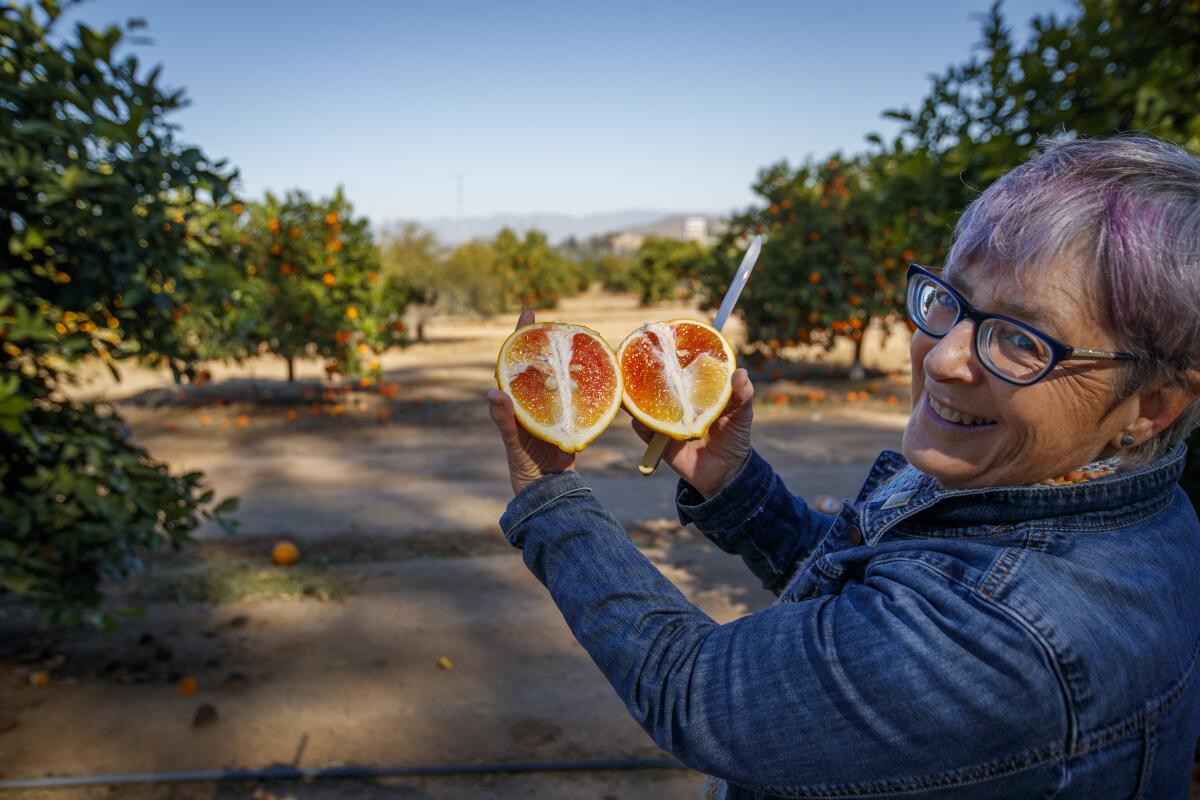
But now, an apocalypse is nigh.
A bacterial infection known as citrus greening, or Huanglongbing, transmitted by the moth-like Asian citrus psyllid, has upended the agricultural world. It’s harmless to humans, but reduces trees to withered, discolored shells of their former selves that produce inedible, immature fruit.
“We’re getting to a point where it’s kinda scary,” said Tracy Kahn, who has been the Citrus Variety Collection’s curator for 25 years.
The world’s most insidious citrus disease invaded Florida in 2005, wreaking havoc on its iconic groves with stunning speed.
She and her colleagues knew it was only a matter of time before citrus greening tried to invade their Eden.
Originating in China over a century ago and first spotted in California in 2012, the disease has ravaged citrus wherever it’s appeared and presents an existential threat to the industry. Citrus greening has caused $2 billion in losses in Florida, where it first entered the U.S. in 2005 and is now estimated to affect 90% of the state’s groves.
Nothing — not the release of parasitic wasps that attack Asian citrus psyllids, or $125 million in congressional funds, or even the use of dogs trained to sniff out citrus greening in trees — has stopped its slow spread. A 1,127-square-mile quarantine zone that encompasses parts of Riverside, San Bernardino, Los Angeles and Orange counties seems to grow every couple of months.
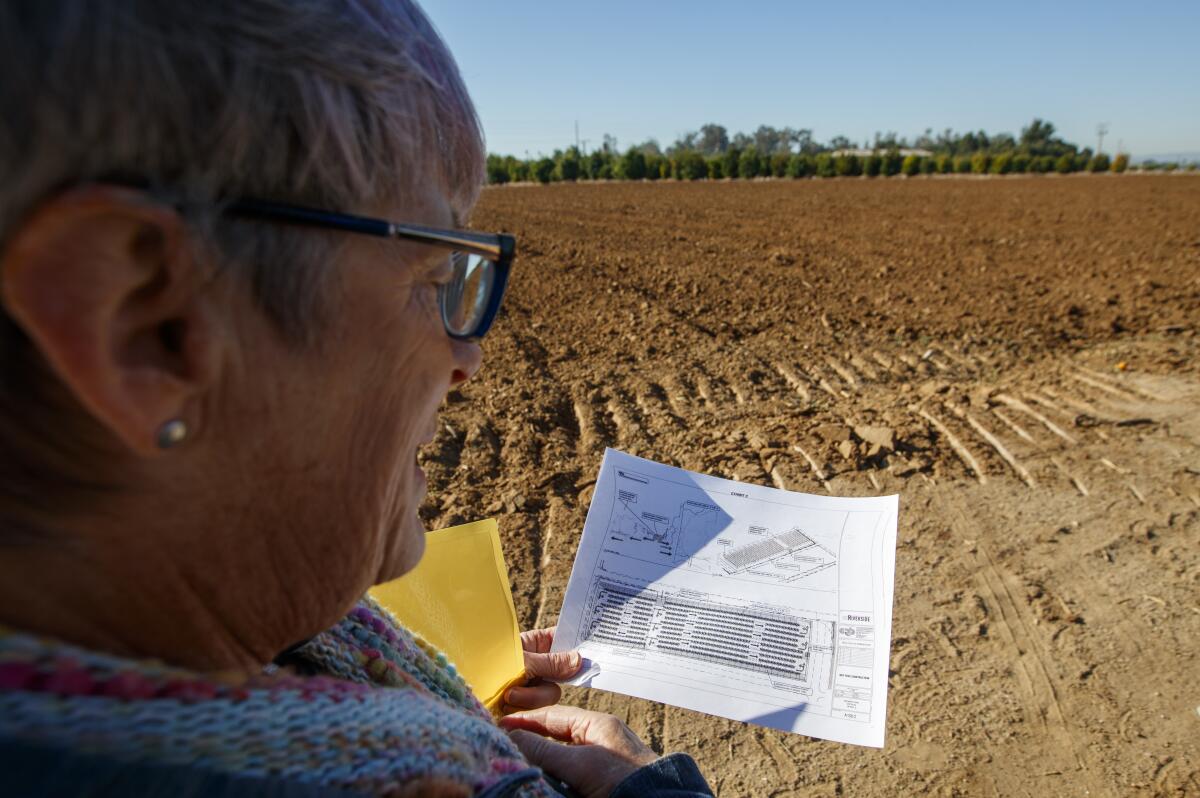
There is no cure in the near or far future, and no foolproof way to contain the disease. The only solution right now for affected trees is to rip them out and replant new ones. That’s what Kahn would do if the collection was compromised. But the ultimate problem such a scenario would present is more symbolic:
If the Givaudan Citrus Variety Collection isn’t safe from citrus greening, then no backyard tree or commercial orchard is.
Kahn recently took Dawn Streich, global citrus product manager for the Swiss flavor and fragrance company Givaudan, here on a bright, crisp morning. Near a section dotted with lush pomelo trees, the two stopped and looked over a freshly tilled dirt lot just south of the main campus of UC Riverside. They gamely smiled.
Here, the Citrus Variety Collection was preparing for a last stand.
In 2017, Riverside County agricultural officials announced they had discovered an infected tree a little over two miles away. The news shook Kahn and her colleagues at UC Riverside’s College of Natural and Agricultural Sciences. For more than a decade, they had collaborated with researchers across the world on how to fight citrus greening and tried to reassure increasingly frantic farmers that a solution would happen.
And now, the disease was on their doorstep.
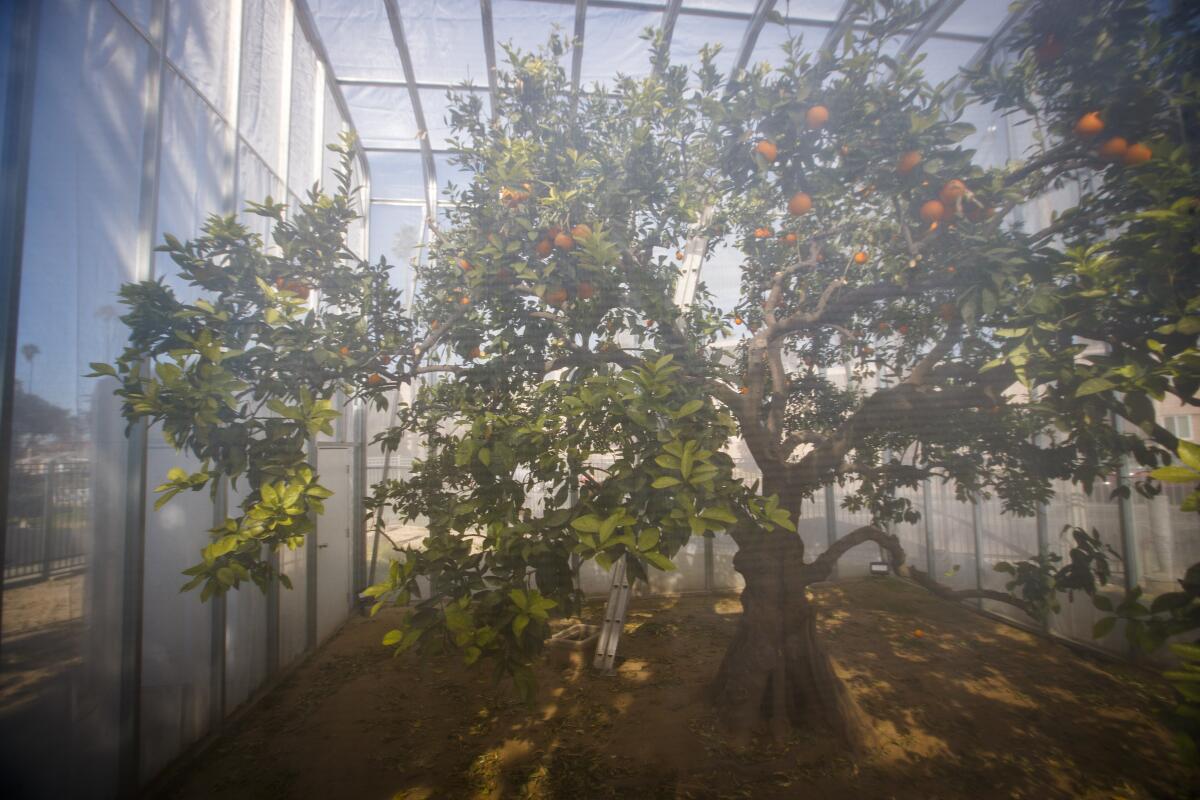
“I’m not retiring until we’ve got something good to deal with this,” said Kahn, 64, as she brushed back her short, purple-streaked hair. For now, the solution was a retreat of sorts: a nearly 3-acre screened structure built on the dirt lot, funded by a $3.5-million Givaudan gift.
Inside, Kahn will oversee the planting of 1,000 trees reflecting the collection’s rarest or most important holdings — a safe space in the case citrus greening overtakes the rest of the collection.
“There’s definitely a fear that something catastrophic can happen here,” Streich said. “So we’ve got to protect this treasure.”
The development has saddened industry observers, but it also serves as a reminder of Huanglongbing’s unstoppable march.
“The deadly citrus disease is in no way selective of which trees get it and which do not,” says Casey Creamer, president and chief executive of the California Citrus Mutual, a trade association that represents the Golden State’s citrus growers.
“If it happened, it would be sad and disappointing, but it’s hard to imagine it not getting to the collection,” said Melinda Klein, chief research scientist for the Citrus Research Board. “It’s a numbers game, and the numbers aren’t really with us at this point.”
Kahn remembers hearing the news about the disease appearing just down the street from the Citrus Variety Collection on a plane ride to the Central Valley for a citrus greening conference. Joining Kahn was Georgios Vidalakis, head of UC Riverside’s Citrus Clonal Protective Program.
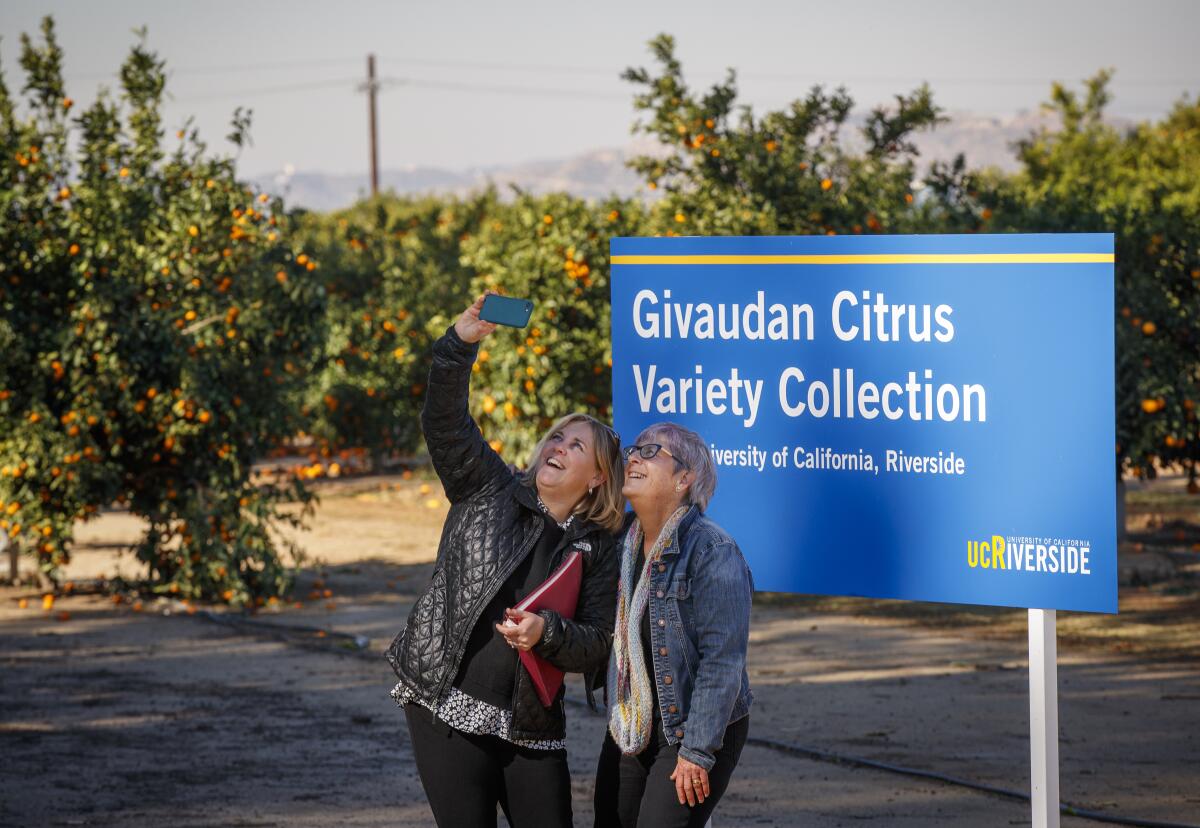
“I turned to him and said I was worried sick,” Kahn said.
Vidalakis was initially doom-and-gloom as well.
“I told Tracy, ‘In the war of insects versus humans, it’s always going to be insects,’” he said.
But then he composed himself.
“As Georgios and Tracy, we freak out,” he said. “But as directors, we compose ourselves and move ahead. We’re going to do the best we can for the whole industry.”
By then, UC Riverside had already implemented backup plan upon backup plan for its personal doomsday.
Vidalakis has overseen the genetic preservation of each specimen in the collection, while a USDA-run greenhouse within the collection has hundreds of disease-free trees in small pots.
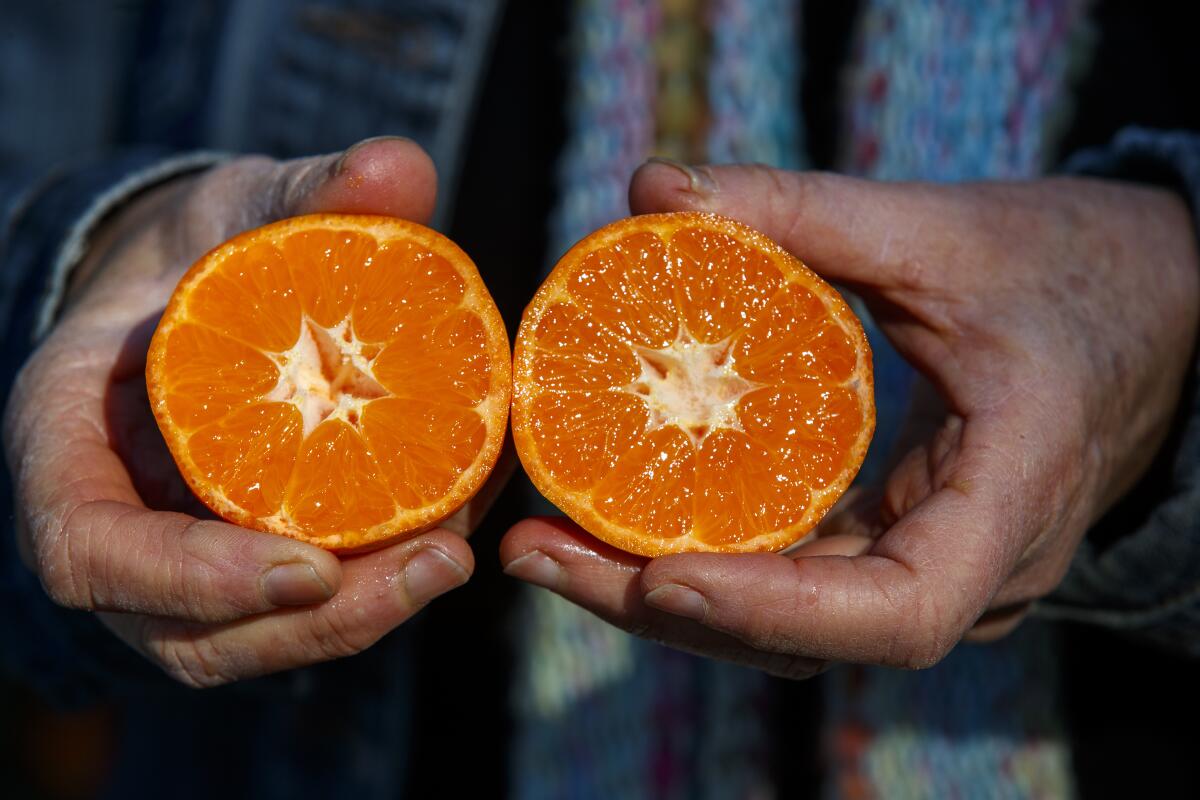
In October, UC Riverside opened an $8-million lab with funds raised by the Citrus Research Board. There, scientists will deliberately infect trees in a secure environment to test out cures and try to breed disease-resistant trees. And about 15 minutes away from the Citrus Variety Collection, the school has helped with a test run of sorts for the collection’s $3.5-million structure with another part of California’s agricultural heritage: the Parent Washington Navel Orange Tree.
Planted in 1873, it was the first of its kind in the United States and helped to make oranges a viable crop in Southern California. Currently 17 feet tall, the tree stood largely undisturbed in a small, fenced-off corner of Magnolia and Arlington streets until 2018, when the threat of citrus greening required action.
Riverside officials first put the Parent Navel under a cloth tent. But with a donation from UC Riverside, it now stands within a 40-by-30-foot structure with white, breathable screens as its walls.
The tree is currently fruiting as if all was right in its world.
“It’s such an important piece of our history,” said Adolfo Cruz, director of Riverside’s parks, recreation and community services department. His workers regularly check the Parent Navel to ensure that citrus greening hasn’t breached its structure.
“It’s just devastating when you look at the groves” affected by citrus greening, Cruz said. “People can’t imagine that here right now, but if you can imagine all our trees looking like that … it’s pretty scary.”
So far, the success of the tent — technically called a citrus under protective screen, or CUPS — has Kahn and Vidalakis hopeful that their multi-acre plans for the collection can be successful. Nevertheless, the two know their industry’s history too well and understand things will probably get worse before they get better.
They only have to remember that existential threats to the Citrus Variety Collection seem to happen every generation or so.
In the 1950s, a virus-borne citrus disease known as quick decline but more commonly referred to as tristeza (“sadness” in Spanish) dealt a nearly mortal blow to California’s citrus industry. Trees died overnight, and farmers in Orange and Los Angeles counties mostly sold their orchards to developers, who went on to create suburban Southern California.
Kahn said that the collection had to be regrown completely in 1981 with root stocks immune to tristeza. And at the beginning of the 20th century, Vidalakis said, a fungus ravaged California’s then-nascent orange industry.
“All this pressure” to beat citrus greening for the world and the Citrus Variety Collection, he said with a grim laugh. “We’re trying to find in 15 to 25 years a problem that no one has found a solution for the past 100 years. But we have faced challenges before. We know it’s doable.”
More to Read
Sign up for Essential California
The most important California stories and recommendations in your inbox every morning.
You may occasionally receive promotional content from the Los Angeles Times.










